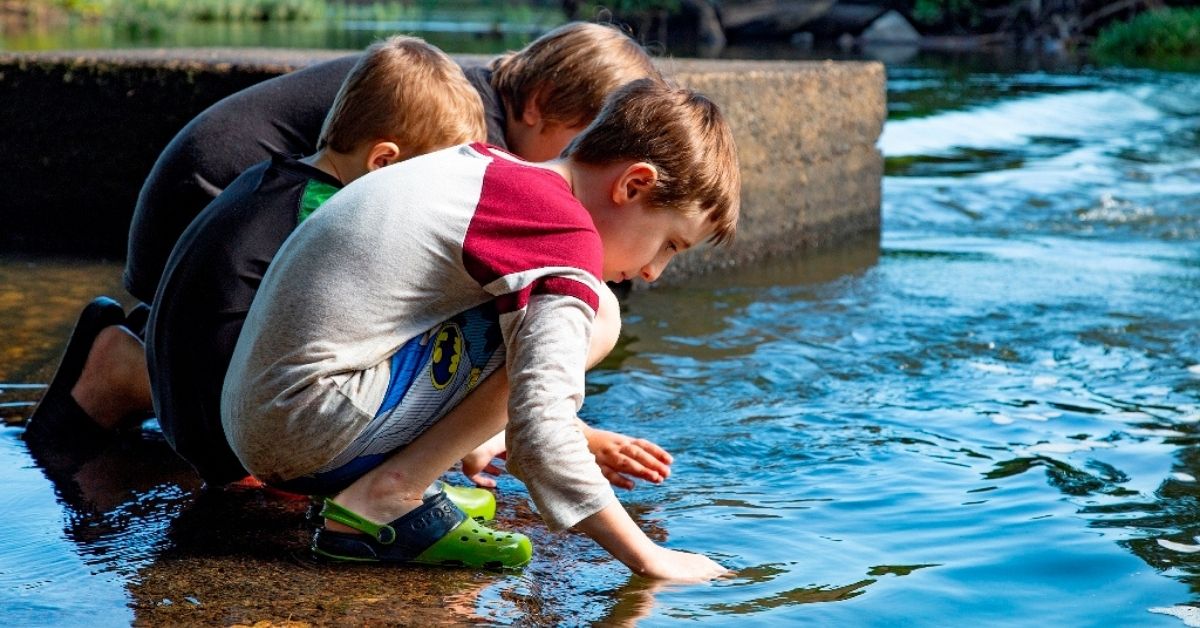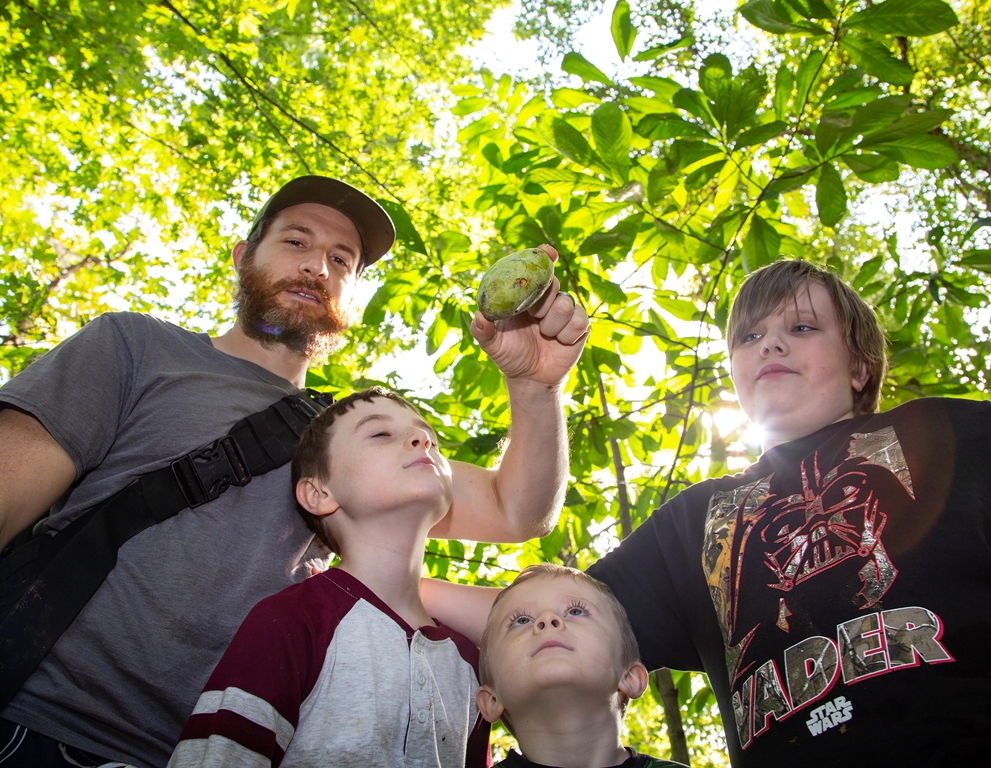
It's fun for kids to just explore with their hands.
By James Walton
Photos by Lynda Richardson/DWR
We often cast blame on our busy life for what keeps us from trekking into the wild with our kids. This can prevent us from breaking them free from their own technological shackles.
“We need the tonic of wilderness,” as Thoreau said!
If you’re not familiar with adventuring outdoors, you might worry about the river’s rushing waters, the snakes hiding about, the sharp, pointy dangers that lurk beneath the surface, and of course the poison ivy, stinging nettles, bugs and whatever else might be buried under those muddy banks.
Most children hold none of this fear and look at nature as sheer opportunity. Nature brings all sorts of interesting things out of the people we love—things we never knew existed or forgot about altogether.
Even at the playground, children are limited by the mulch-filled boxes in which they play. They can only climb as high as the metal is built and they are consistently under the watchful eyes of parents encircling the entire area.
The woods, creeks, and rivers are boundless. The water goes on forever, the trees are so tall that little arms can climb them all day, there is the allure of something giant lurking just under the baited hook and to kids it’s all magic. Soaked and laughing, mud between their toes, the spirit of the human child is uncovered.
Yes, tech is invasive and video games can hijack our children’s minds, but nature has a grip on them that is as old as our own species! If you know how to engage them, the video games and electronics haven’t a chance!
So, what do you do with children and teens in the outdoors?
NOTE
In order to do these things safely and make them fun, you have to be involved and you have to be a guide. You also have to be prepared to see your efforts fail. There is a chance you offer up a day of fishing, catch nothing, and your kid goes home miserable. Oh well, put fishing off for the next few weeks.
You have to either learn these things in preparation for teaching children, or aspire to learn them together with your kids as an adventure. They love it when you are not the expert and learn right alongside them. Keep in mind that safety should be your No. 1 priority, so make sure you have resources to identify plants and animals you encounter, and be vigilant when children are near the water.
In The Water
Rocks underfoot and cool running currents make for the most interesting “pool” your child has ever swam in. This is a true bonding experience between your kid and the wild. Our polished and chlorinated swimming experience shapes our idea of what swimming is all about, but kids love to combine swimming on sunny days with the prospect of flipping rocks to find out what lurks beneath. It is here they find things like snails and nymphs. Flipping rocks in calmer pools might reveal a crawfish and those are always intriguing.

There is no better way to explain the lifecycle of bugs than to show them the pupae casings, the stonefly nymphs, and even the shells left over from the emerging species.

There is much more to do than swim when you are in the river. Constant supervision of children around the water is necessary for safety, and
Fishing
This one is a no-brainer, but it doesn’t have to be a matter of simply fishing by traditional means. What about using a cane pole, a cast net, or even employing some survival fishing techniques like a fish weir. The weir is a simple collection of sticks poked into the ground in the shape of an M that allows the fish to swim into the trap but not get out.
The trapping and netting of fish also allows for easy release if you are not interested in keep the fish or if they are not regulation size.

Metal Detecting
Basic, affordable metal detectors of today are distinctly superior to beginners’ units that I used in my youth. Getting outside and searching for metal treasures is another reason to get lost in the woods. Most of the modern detectors are waterproof up to a certain point. Just make sure you have permission to metal detect on any property you explore. And note that metal detecting is not allowed on any Virginia Department of Wildlife Resources (DWR) Wildlife Management Area (WMA) or other DWR property.
A simulated treasure hunt is always going to peak the eyebrows of the youth. The potential of unearthing some valuable relic of the past holds appeal at all ages.
Foraging
Do you eat the wild? Foraging can require a bit of prerequisite knowledge but once your find a few wild edibles to enjoy, your kids will look forward to them every year.
“Is it paw paw season yet?” my son Carter asks every year around the end of August. He is 9 and has come to understand that a few weeks after his birthday, the paw paws start falling from the trees. This oblong and tropical fruit found near water in central and southern Virginia is a true treat.
Imagine a banana and a mango had a baby that didn’t mind cold southeastern winters. That is the paw paw fruit. It is creamy, rich and sweet. We have tons of them growing in our yard, but we also like to seek them out at the end of summer while we swim or fish in the James.

Geocaching
While metal detecting is the process of happening upon treasure by chance, geocaching is the act of following a legitimate treasure map! A geocache is a hidden box or destination that is marked by GPS coordinates.
The geocaching app shows you those coordinates on your phone and you can seek these treasures out. The thrill here is following the map and finding the geocache itself. They are often well hidden, which makes it all the more fun. Please note that geocaching is not allowed on any Virginia Department of Wildlife Resources (DWR) Wildlife Management Area (WMA) or other DWR property.
Kids love the opportunity to head out to the local park, river or even just around town to find them. Geocaches are all around you but without the app you would never notice them. This is also a great way for kids to understand navigation using a map. This will require a cell phone, so it is not screen-free, but it’s a still a great time!
Conclusion
A paw paw fruit on the sandy banks of the river under the still warm September sun is about as pleasant a time with kids as you can hope for. They will relish a day of rewilding as long as you have the confidence and the patience to let them be kids. Keep the boundaries at a minimum while still ensuring safety. Get involved.
Many of you reading this understand the great balance that is achieved when you spend some time in nature. The kids need a taste of that, too. However, a calming hike with breath exercises is not what your kids are after. They want to scream and splash and discover new creatures, dig holes, climb trees, and reconnect with what human kids have been doing for thousands of years.
James Walton of Richmond is an avid angler and freelance writer.

